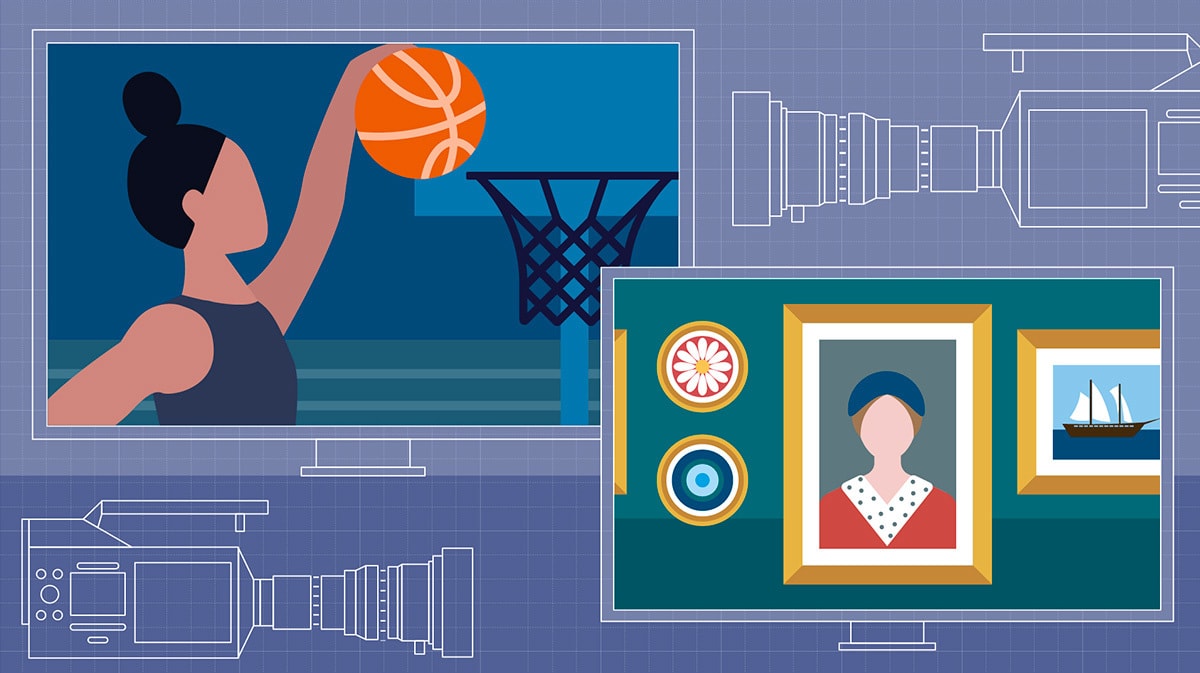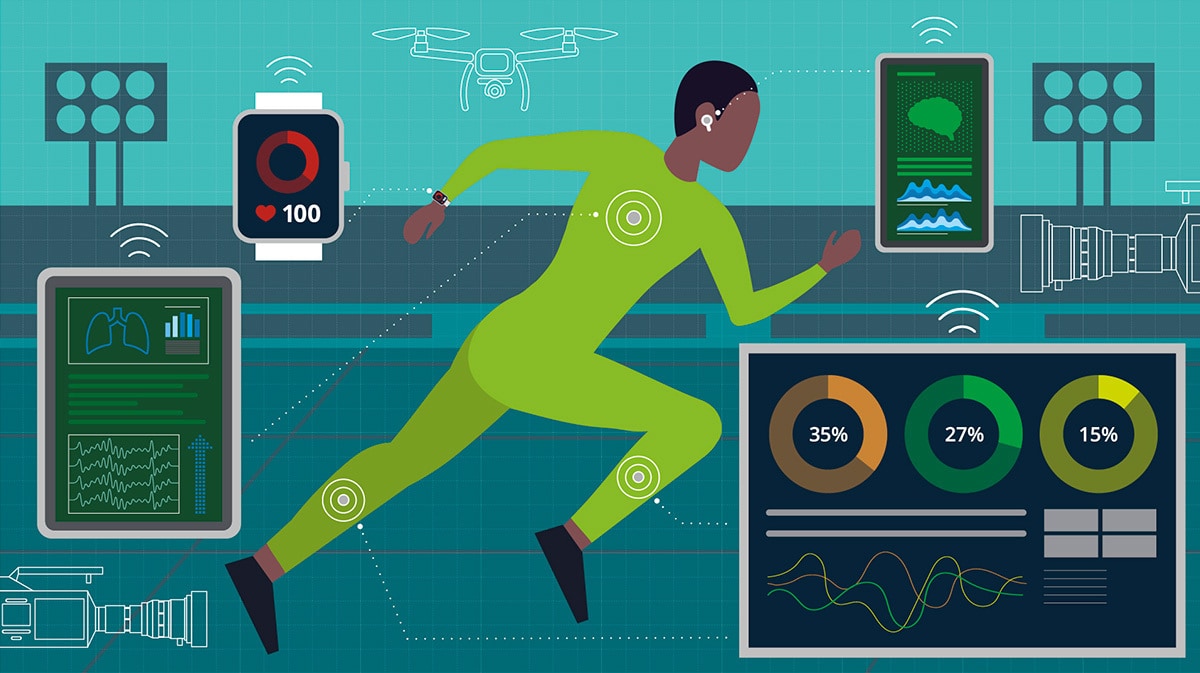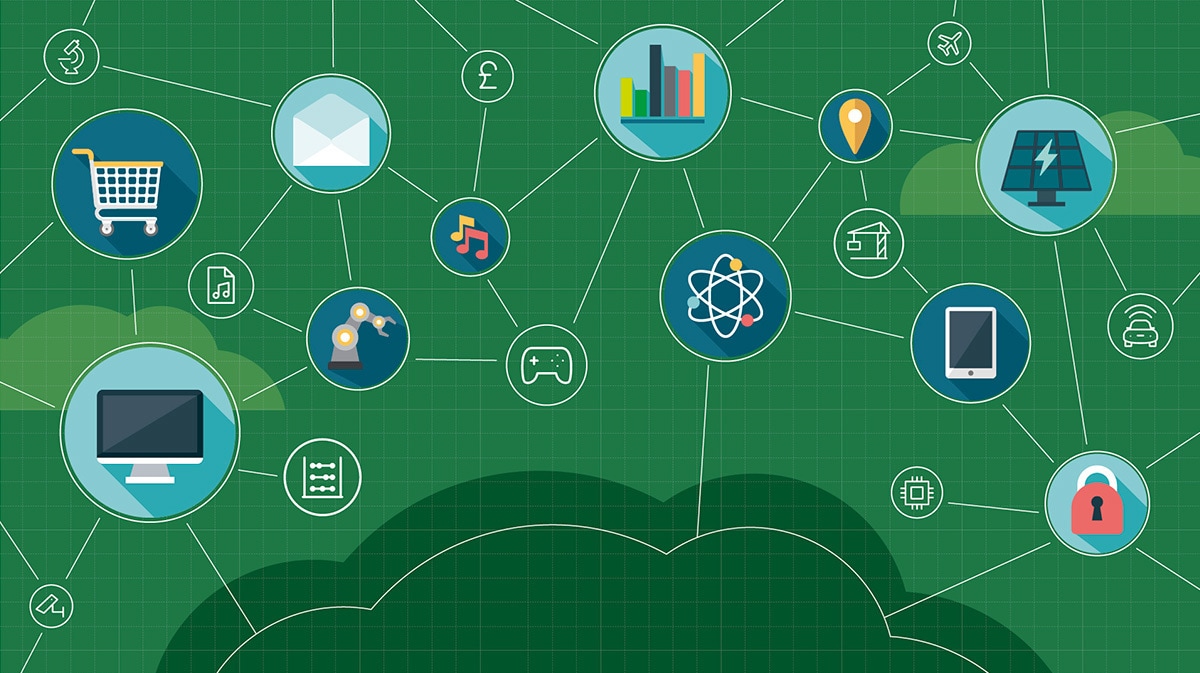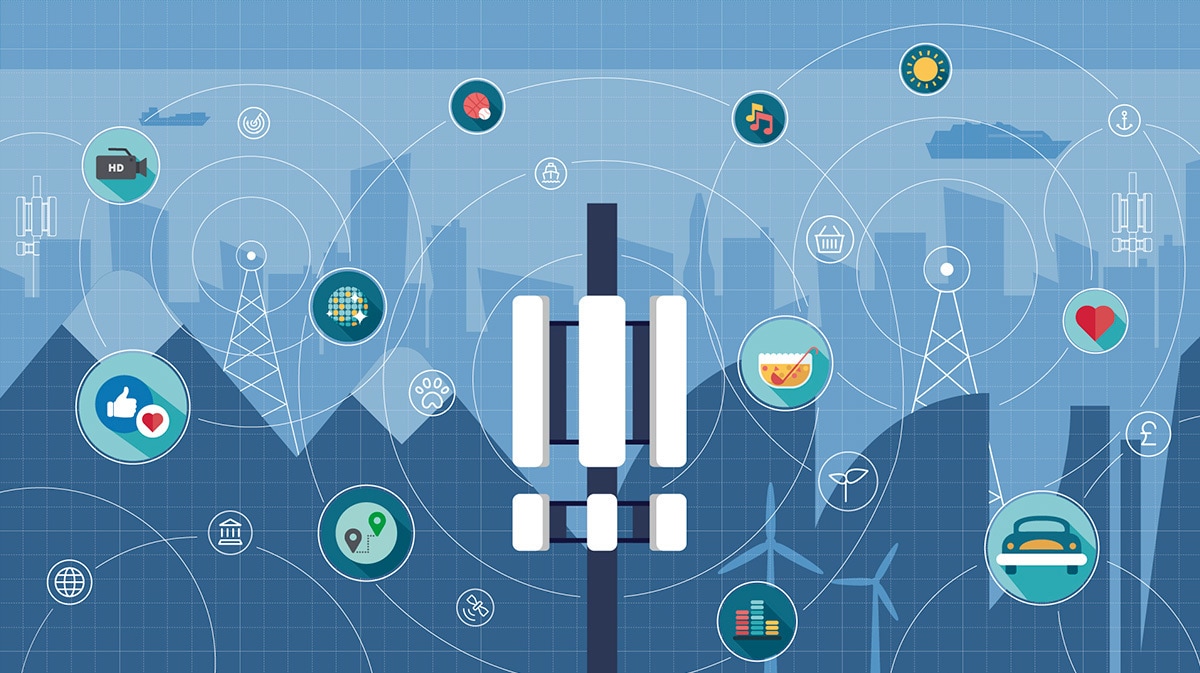Discover the future
2021 predictions for UK Technology, Media and Telecommunications
Authors: Paul Lee, Cornelia Calugar-Pop
What does the future hold for technology, media, and telecommunications?
We can’t talk about 2021 without mentioning COVID-19. All six of our TMT Predictions topics for this year were shaped to some extent by the pandemic. We hope that during 2021, we will be focusing on thriving in the future rather than responding to the present.
COVID-19 has been a catalyst for needed changes across the TMT landscape. For instance, Movements to the cloud, and to the intelligent edge were already underway in 2019, but they have been accelerated by years or even decades because of the pandemic. The rising interest in women’s sports and the hyperquantification of athletes may make sports viewing more compelling in a time when stadiums are less accessible.
See what you think… welcome to TMT Predictions 2021.
Join the conversation #DeloittePredicts #TMTPredictions
2021 Predictions
-

First, some facts about women’s sports:
- 993 million people watched the 2019 FIFA Women’s World Cup on TV. A further 482 million accessed it via digital platforms;
- 77,868 fans watched England’s women’s football team play (and lose) to Germany at Wembley Stadium in November 2019, a little more than the 77,277 fans who watched England men’s against Montenegro that same month;
- 84 per cent of sports fans, half of whom are women are interested in at least one women’s sport.
Next, the prediction: despite women’s sports impressive performance in terms of viewing, attendance and interest, we forecast revenue from women elite sports will be under a billion dollars in 2021. Contrast this with the global value of all sports (men’s, women’s and mixed) of $471 billion (£353 billion) in 2018.
We further predict that over the course of the decade, revenue should grow strongly. We base this prediction on women’s sports’ recent track record across elite sport’s three main revenue streams: TV rights, event day attendance, and sponsorships.
Women’s TV rights are building momentum, from a low baseTV rights are the biggest source of revenue for major sports rights holders.
To date, women’s football has enjoyed the biggest TV audiences. The 2019 FIFA Women’s World Cup USA-England semi-final match reinforces these statistics. In the UK, 11.7 million people watched the United States beat England, representing just over half of the total TV audience at that time. This number set a viewership record for a female football match and made the game the UK’s most-watched programme in 2019 at that point in the year. The final was watched live by 260 million viewers, including 14.3 million in the United States.
Nor are audiences lacking for other women’s sports. From cricket to netball, many women’s teams are showing strong viewership, especially when the national team is playing. In rugby, 2.6 million viewers in the UK watched the final of the 2017 Women’s Rugby World Cup between England and New Zealand: 56 per cent of the TV audience for this event was male. In netball, 550,000 people in the UK watched the semi-final of the 2019 Netball World Cup.
TV rights for women’s sports are rising in value worldwideIn the UK, the BBC reportedly paid £9-£11 million for the rights to the Women’s Euro football competition in 2021 (now 2022) being hosted in England, up from the less than £1 million that Channel 4 reportedly paid for the 2017 edition.
Also in the UK, where BT Sport and the BBC have a three-year deal with the Women’s Super League (WSL) football franchise from 2018–2019 to 2020–2021, rights have been awarded on the basis of guaranteed coverage. BT Sport has committed to show 30 live matches per season, while the BBC is showing one live match per week via online or on-demand channels.
Women’s sports games are filling major stadiumsIn recent years, audiences for women’s sports in the tens of thousands have become far more common.
National games are among the most popular for matchday attendance. In November 2019, a record 77,868 fans watched England versus Germany at Wembley. The Women’s Six Nations rugby tournament has also been popular among fans. A (then) record 10,545 people attended the England-Italy match in March 2019. This record was then surpassed a year later, when 10,974 fans watched England versus Wales.
Club games also draw significant crowds. In March 2019, 60,739 football fans watched FC Barcelona Femení beat Atletico Madrid at the Wanda Metropolitano stadium in Madrid, beating the prior attendance record for a women’s fixture of 48,121 at the same stadium. In November 2019, 38,262 football fans attended the women’s “Super Derby” at Tottenham Hotspur between London rivals Spurs and Arsenal. Anfield, Liverpool FC’s stadium, drew 23,500 fans to its local derby against Everton, the first-ever WSL match it had hosted.
Sponsorship: In its infancy, but on a strong trajectoryThe global value of sports sponsorship is about $45 billion (£35 billion) per year, of which women’s sports is a fraction. But strong TV and matchday audiences are encouraging more sponsors to consider women’s sports. The nascency of the market may make women’s sports better value for money than the men’s equivalents.
As sponsorship interest grows, rights for women’s teams are increasingly being sold individually rather than being bundled with the men’s team. Indeed, by the time of the next FIFA Women’s World Cup in 2023, we expect all women’s teams to have at least one sponsorship agreement distinct from the men’s teams.
Several recent agreements exemplify the growing role of sponsorships in women’s sports. In 2018, Visa signed a seven-year deal to become the first-ever sponsor of UEFA women’s football, becoming the main partner of the UEFA Women’s Champions League and the UEFA Women’s European Championship. In 2019, Boots signed a three-year deal to sponsor the women’s national football teams of England, Wales, Scotland, Northern Ireland, and Ireland.
The bottom lineThe most important lesson from all this is that women’s sports has immense potential value, not just in monetary terms, but also in terms of what it signals for gender parity. For women’s sports to fulfil its potential, however, requires action by all interested parties:
- Broadcasters should continue to invest in women’s sports.
- Women’s teams should slipstream men’s teams, but also keep their distance.
- Video content creators should consider the value of female athletes’ stories.
- Significant women’s events should take place in the largest stadiums available.
- Sponsors should capitalise on their amazing opportunity in women’s sports.
Change takes time, and it may take a decade, or even a generation, for women’s sports to attain its full potential. But its promise of delivering value to sponsors, investors, fans, and athletes and teams themselves is becoming more and more clear.
A view from our experts
“2021/22 may prove to be the breakaway season for women’s sports revenues. Prior to Covid-19, matchday audiences, TV viewing figures and fan bases for women’s sports had been building at phenomenal pace. As social distancing measures lift, pent-up demand for live sporting events will collide with the growing fan base for women’s sports. Brands have a significant opportunity to seize the moment to explore new opportunities in the market, which have the potential to bring immense value, not only in monetary terms, but also as a signal for their support of gender parity.”
Izzy Wray
Consultant in Deloitte’s Sports Business Group
Email: iwray@deloitte.co.ukShare this prediction:

Deloitte predicts that 2021 will be 8K TV’s first million-unit year, generating £2.5 billion in revenue globally. While units will be less than one percent of the 200 million plus sets sold annually, average selling price (ASP) at £2,500 is much higher than the overall at £335.
Sales of 8K TV sets are likely to grow in line with price declines – as happened with 4K and HD. Prices have already fallen fast in the last three years. In 2017, the ASP for 8K sets was more than £6,000. The following year, it had fallen to £4,100. We expect that by the end of 2021, the entry-level price for 8K TVs may fall to the critical £1,000 level, spurring many consumers with a £1,000 budget for a TV to opt for the 8K model.
What is 8K?The 8K standard is named after its resolution, which is 7,680 horizontal x 4,320 vertical lines on a 16:9 aspect ratio screen, equivalent to 33 million individual pixels, versus 8.3 million for 4K. The 8K standard also includes specifications for:
- Frame refresh rate: up to 120 frames per second.
- Colour range: every colour available in nature can be displayed. Additionally, 8K provides improved dynamic range related to brightness. This will make content look noticeably more vivid.
- Audio with 22.2 channels of surround sound. This delivers soundtracks and dialogue with more complexity.
Content viewed on an 8K TV will therefore not only have higher resolution, but also look and sound better
8K TV sets do not need native 8K content to sell8K sceptics are likely to centre on the lack of native 8K content. We predict less than 0.1% of all video content created in 2021 will be in 8K. An even smaller proportion of the total base of video content (TV programmes, movies, user-generated content, and video games) will be 8K. And this will not matter.
It has not mattered for 4K. Nor did it matter for HD. In 2021, less than 5% of content available on SVOD and less than 1% of broadcast programme hours will be 4K. Yet over half of all 4K TV sets will be sold.
There will be an abundance of content to watch in 8K in 2021Enough 8K content already exists for an owner of an 8K TV to spend every hour of every day throughout 2021 watching 8K material—without watching a single repeat. How so?
Upscaling: 8K sets can upscale 4K to 8K using an artificial intelligence capability which converts 4K images into realistic 8K. The TV scans every frame, and identifies objects within it, such as a pair of black sunglasses or a green apple. Each object is then upscaled realistically to an 8K image, by adding three pixels for every 4K one. The resulting frame will be in 8K, based on a composite of upscaled objects, each converted in real time. As processing power in TVs improves, so will the calibre of upscaling.
Remastered 70mm analogue and digital content: Movies shot on 70mm film have a resolution equivalent to 8K. A few 70mm movies have already been remastered in 8K (e.g. 2001: A Space Odyssey). Most iMax movies are shot on 65mm or 75mm as well, so these could be converted to 8K.
Content shot natively in 8K, but so far only released in 4K or lower resolution. For example Money Heist season four was shot in 8K, but released as 4K. In time, this could be additionally released in 8K. BT Sport shot a football game featuring Arsenal versus Olympiacos in 8K in March 2020.
User-generated content: Current smartphones have 12-megapixel (MP) cameras, which capture images in 12 million pixels. 12MP images can only be displayed in their full resolution on an 8K TV: A 4K TV, with a mere 8 million pixels, is insufficient. A few high-end smartphone models can also capture 8K video.
Prosumer content captured in 8K or greater than 4K: Prosumer photographers now have access to compact 8K cameras whose cost starts at about £3,000. Some of this content is available via YouTube and Vimeo.
Game consoles with 8K support: 2021 will be the first full year in which a new generation of 8K-ready game consoles will be sold. 8K titles are likely to become available post 2021.
8K’s uses beyond entertainmentOver the last few decades, the applications that a TV is put to have steadily expanded. 8K TVs are likely to host applications beyond entertainment, including:
- remote working. An 8K panel could be used to display multiple pages of content - perhaps a blend of diagrams, video calls, charts, and data sheets that a person or team is working on, as well as people – in full size and crisp definition.
- online exercise classes. Large 8K screens, displayed on a wall, would enable instructors and fellow athletes to be shown larger—even life-size.
- digital wallpaper. Ever since the advent of digital screens, digital images have been used as screensavers.
8K’s production endCreating content in 8K offers several advantages. One of these advantages is that shooting in 8K may allow for better quality in postproduction. Downsampling 8K video to 4K often delivers a cleaner overall image than footage originally captured in 4K. 8K capture for 4K masters is likely to be particularly useful for movies with many visual effects (VFX), whose images can be subject to significant postprocessing. Reframing from higher-resolution images is also easier in 8K. Crops at 4K resolution can be readily created from an 8K file without loss of resolution, delivering smaller pixels and more detail.
The bottom line
Commentators should not dismiss 8K’s prospects on the grounds of irrationality. Similar arguments were made about 4K: resoundingly logical objections around the size of the screen for instance did not have held sway.
Share this prediction:

Deloitte predicts that by the end of 2021, over 10,000 players in the UK’s professional and amateur sports teams will apply video analytics to improve their play. By the end of 2023, 100,000 athletes will likely be benefiting. These coaching techniques, based on the combination of artificial intelligence (AI) and video footage, have been available to elite teams across multiple sports for several years. But usage is likely to become significantly more widespread in 2021 and beyond as the cost of video analytics steadily falls with basic systems becoming available to any team at almost zero marginal cost.
Coaching improves a player’s performance. Coaches can guide players during training, before matches, and offer feedback post-match. But a coach – or indeed a coaching team – cannot process every move from every player. There is far too much information to process, while human memory does not retain footage, or indeed every quantifiable event. According to one estimate, a 90-minute football match can generate 3.6 million data points. Even for those teams with access to filmed footage, analysing each player in each game is likely to be too labour-intensive, and too costly. This is where video analytics, which automates the generation of these analyses, comes in.
Video footage, twinned with ever more capable AI, provides a powerful, accurate and objective complement to a human coach. For example, a key requirement in any team sport is to stay in position relative to another player. Video analytics can analyse footage to identify players who stray out of position relative to their mark, even by half a metre – which could be enough to enable an opposing player to find and exploit a gap. Prior to the availability of this capability, a trainer would have to judge distance by eye: technology provides a constant, accurate digital tape measure.
Video analytics can be applied to archive video footage to quantify a player’s progression over time for a range of standalone metrics from shooting accuracy to raw speed. But it can also be used to assess a player’s capability to maximise their team’s likelihood of scoring. Machine vision can analyse the context in which a player takes a shot – the proximity of other players, the distance from and angle to the goal. A good player would shoot only once when they have found space to make the shot: automated video analysis can quantify how adept a player is at this. And this can determine a player’s ability to score decisive points, and ultimately to contribute to a win. It can also be used to assess the quality of a player’s positioning off the ball, which can also be critical to a game.
In 2021, top sports leagues such as the English Premier League, the Bundesliga or the NBA are likely to use ever more sophisticated analytical capabilities. But it is also likely that teams in other leagues across all sports, including semi-professional teams, will start to use these techniques as an input into training. For example, Stockport County, which is in England’s fifth tier football league, has started using this technology. And over the course of 2021, we would expect other teams at lower levels to also start adopting the technology.
The key enabler of the democratisation of video analytics is deflation, with costs falling to literally zero for basic capabilities in 2020. Smartphones, whose video capability is steadily improving, can be paired with software from companies such as Metrica Sports, which offers a basic plan for free and is a supplier to elite football teams. Standalone SLR cameras, with better optical zooms, costing a few hundred pounds, can also be used. 8K cameras, which capture images in very high resolution (33 million pixels, and four times the resolution of 4K), are now available from about £4,000 – still too expensive for most teams, but prices are very likely to fall. Drones, which cost from a few hundred pounds, also be used to provide overhead views. The incorporation of LIDAR, which uses light beams to measure distance from the device, into the latest smartphones can also be a useful additional tool.
The price of specialised machine learning capability, based on hardware and cloud-based software, can make any and every IP-connected camera capable of machine learning and computer vision. These capabilities – now priced from under £200 – are being marketed principally at businesses. But suggested applications, which include measuring distance between workers (think players) or generating retail insights from shop floors by analysing shopper journeys (think of player movements) may also be useful for sports.
Hundreds of teams in the UK could also tap into price declines in complementary technologies, such as private cellular networks. Base stations could be deployed at training grounds to enable bespoke connections between cameras and computers. The cost of a local area cellular licence in the UK can be as low as £100 per year. The cost of a base station is from a few thousand pounds.
Video analytics can even be used by individuals to train at home. Balls equipped with sensors can be paired with smartphone apps to enable players of all ages to improve their technique in their living rooms or back gardens. A smartphone is used to capture and analyse movement from a specialised football or basketball; real-time guidance is provided on a television screen. Even lower cost options are available. HomeCourt: Basketball Training just requires an app download and for a phone to be positioned with a clear view of a court. Shot tracking is free; workout analysis is available for £7.49 per month.
The bottom line
Elite sports teams have increasingly harnessed data to improve on-pitch performance. As technology has improved, so has sports’ application of a growing array of technologies. And as the cost of individual technologies falls, these capabilities will become available to more teams, improving outcomes for a wider range athletes.
Technology for sports is democratising rapidly. As recently as 2019, Pep Guardiola’s mandate to training staff to take drone-flying courses to allow them to see training sessions from above made national news. As of 2021, thousands of teams across the UK should have access to the same functionality, drone regulations permitting.
Of course, video analytics among elite teams will not stand still. The top teams are likely to use ever more sophisticated analytical capabilities, deploying the latest generation of technologies include intelligent edge, 8K cameras, 5G cellular mobile and Wi-Fi 6 to enable yet more efficacious analysis. And video footage alone will not suffice for the teams at the very top: they will pair this with wearables and arrays of sensors. But the capability and pricing of video analytics is likely to advance fast.
A view from our experts
“Marginal gains are the small differences that secure victory in elite sport. Technology has had a key role to play in identifying and securing those gains. As that technology continues to evolve at the elite level, so the existing technology becomes ever more accessible to non-elite athletes to track and improve their own personal best performances.”
Dan Jones
Partner, Sports Business Group
Email: danjones@deloitte.co.ukShare this prediction:

Deloitte predicts that cloud revenues will increase 30 percent or more between 2021 and 2025. Three main motivations, whose importance has been elevated by the pandemic, will drive growth: cost savings, driving innovation and the quest for agility.
Cloud has already proven critical: 51 per cent of UK business leaders believe that shifting to a cloud computing business model saved their company from collapse during the pandemic. Cloud is likely to prove equally differentiating as companies recover and thrive post COVID-19.
Growth in cloud revenues was at triple-digit levels worldwide as recently as 2015, after which point growth rates inevitably slowed. Growth was 31 per cent in 2019 and was expected to moderate further in 2020 and 2021. But expectations changed and growth forecasts have been revised up.
The pace of cloud adoption is likely to deliver some key inflection points. For example, by 2021 the majority of enterprise workload globally is expected to be in the cloud for the first time. According to a global survey of 50 CIOs, undertaken April 2020, the proportion of total workload done on-premise will fall to 35 per cent in 2021 from 59 per cent in 2019. Respondents expect public cloud’s share to grow from about a quarter to over a third (23 per cent to 38 per cent), with private cloud reaching 20 per cent and hybrid cloud at 7 per cent of workload, for a total of 65 per cent in the cloud. That transition may have occurred sooner in the UK: according to a 2018 survey of 250 UK private and public sector organisations, UK businesses spent more on cloud infrastructure than on on-premise in that year. Cloud’s growth and its underlying momentum can be seen in revenue and usage metrics for 2019 and 2020, with the context that non-cloud IT infrastructure spending was up about 1 per cent in 2019 and forecast to be down about 10-12 per cent for 2020 (due to the pandemic).
- Hyperscale cloud revenues
The five largest hyperscale public cloud providers saw revenues up £37 billion globally in the first nine months of 2020 relative to the same period in 2019. - Data centre semiconductor revenues
The three largest semiconductor companies that disclose segmented data centre sales saw their combined revenues grow by 36 per cent in the first nine months of 2020. This compares to 3 per cent in 2019. As of mid-2020, the number of hyperscale data centres had risen by 26 to 541 globally, with a further 176 planned over the next few years. This will have a commensurate impact on demand for chipsets. - Global cloud network traffic
Cloud traffic doubled between 1 February and 19 April 2020, measured by bits per day. Cloud network traffic as a percentage of total internet traffic rose from 1.26 per cent to 1.83 per cent, up by 45 per cent over this period. Over the same timeframe, overall internet traffic grew by 38 per cent.
The bottom line
For cloud providers:
In addition to higher capex to accommodate greater usage, providers will need to allocate for AI apps and developer tools, which are critical to attracting and maintaining enterprise customers. Given the continued growth in revenues, it seems likely that capex will continue to grow at double digits, reaching £112 billion by 2022.
As cloud moves from roughly one-third to two thirds of enterprise workflow faster than expected, privacy and security aspects urgently need to be addressed.
Another emerging development for hyperscale cloud providers is the rise of the intelligent edge which combines computing power, AI technology, data analytics, and advanced connectivity to quickly act on data much closer to where it is captured. In this model, hyperscalers need to make sure data created at the edge finds its way back to centralised clouds for analysis and AI training. Cloud providers will also need to develop vertical-specific apps that reside at the edge. Partnerships could enable hyperscalers to deal with both data transfer and app development.
For cloud users:
Cloud migration strategy. Cloud migration is most effective when part of a programme of process reinvention, with productivity and cost improvements resulting. Cloud can enable better collaboration, improved automation, greater scale, and improved agility – but only if planned for. And of course migration should not incur the cost of business interruption.
Cloud and security. As cloud usage grows, the attack surface – the number of ways an attacker could try and breach an environment – increases. A survey of UK decision-makers shows that 39 per cent of respondents agree that the pandemic has exposed gaps in their cybersecurity strategy.
Cloud costs and benefits. As multiple enterprises shifted rapidly to cloud during the pandemic, some saw costs balloon as cloud usage spiralled. Some companies saw costs rise by up to 50 per cent from unplanned usage increases alone, even without adding in the cost of new applications or data.
Cloud and sustainability:
As the importance of sustainability rises in prominence ahead of the UN Climate Change conference in Glasgow in November 2021, the impact of data centres on emissions is under increasing scrutiny.
There are two main drivers of cloud computing’s energy usage. Firstly, if cloud usage doubles, then so would energy usage. Secondly, the application may change: if more machine learning is done in the cloud, this means more energy-intensive computation.
However, techniques are being deployed to lower emissions. Data centres can be designed to be more efficient, for example by deploying AI chips specialised for data centres, by using specialised air-flow techniques, or by locating close to the Arctic for natural cooling. In the last decade, data centres have been able to balance massive growth in computing outputs while maintaining power consumption at close to the same levels. Between 2010 and 2018, energy consumption at data centres rose a mere six per cent, but computing outputs jumped six fold. Furthermore, some AI processing can be undertaken at the edge, reducing the need for the round trip to a centralised data centre.
Share this prediction:

Deloitte predicts that in 2021 the global market for the intelligent edge will expand to $12 billion (£9 billion).
The intelligent edge is an amalgamation of technologies which are likely to be critical to Industry 4.0 – the industrial sector’s reinvention. It places cloud computing, data analytics, and AI physically near where data needs rapid analysis and response. This enables data to be acted on directly or filtered, with only selected data pushed to the core.
Typically, edge refers to the end of a managed fixed or mobile network within 30 miles of an endpoint, such as a connected device or sensor gateway. But it could be closer - onsite, in a vehicle, or on the device itself. Edge intelligence could also be deployed in vehicles and devices able to analyse inputs, such as automatically guided vehicles (e.g. drones, logistics robots) equipped with machine vision for obstacle avoidance.
The intelligent edge is the combination of:
- latest generation wireless connectivity. This could be 5G, later versions of 4G or Wi-Fi 6 (the latest release of the Wi-Fi standard). These technologies enable up to a million objects to be connected within a square kilometre, and permit transmission speeds at up to gigabits per second.
- compact processing power, enabled by advances in semi-conductors. While the most powerful analytical capability will always likely be in dedicated data centres, edge computing power is steadily growing, and is able to undertake a growing array of tasks.
- artificial intelligence (AI). Increasingly, chipsets that are specialised and optimised to run AI and machine learning tasks are moving into edge appliances. More chipset makers are developing edge-specific architectures, often with support for machine learning. This combination of specialised chipsets and AI capabilities is what makes the edge intelligent, with use cases such as computer vision, data analysis, and deep learning shortening and accelerating the decision loop.
The intelligent edge is an element within a holistic cloud-to-edge architecture. It does not replace the ‘traditional’ remote cloud. What is likely is that some components of a service will run in a centralised cloud, others at the data centre, and more yet at the edges on sensor arrays, autonomous vehicles (from fork-lift trucks to consumer cars), and potentially billions of machines.
By 2023, 70 per cent of enterprises may likely run some amount of data processing at the edge. Companies that deploy intelligent edge will do so for a blend of the following reasons:
- To enable low-latency use cases. Cloud applications that require a round trip to a data centre may be rendered less effective by latency. Data travels at the speed of light, but a 200 mile round trip may make an application, such as one for automatically guided vehicles, or to check for alertness in a bus driver, too slow.
- To optimise bandwidth usage and costs. Performing analysis at the edge reduces the volume of data sent to remote data centres, reducing network congestion.
- Increasing resilience, through reducing reliance on the performance wide-area networks (WAN)
Intelligent edge is likely to be applicable across multiple industries.
Oil and gas companies could use it to analyse video sent by drones to inspect infrastructure, to identify potential issues such as cracks in gas pipes. Using intelligent edge, only frames with defects are archived in the cloud to feed models and training sets, which can then update other drones in the field for better spotting. This minimises the data load for analysis and transit and greatly reduces the time between inspection and action.
Demand is also growing from use-case driven solutions such as autonomous vehicles and mobile robotics that require low-latency, high-redundancy capabilities, as well as from manufacturing and supply chains seeking greater transparency and resilience in a post-COVID-19 world.
Further demand may come from the intelligent edge’s ability to address emerging regulations for data sovereignty and compliance. With an intelligent edge, data can be secured and held locally, keeping it within the region it was collected instead of sending it to data centres located abroad.
As the market matures, we anticipate that early growth will be spurred by players such large telecoms companies with enterprise capability, hyperscale service providers, content delivery network (CDN) providers, and technology companies.
The bottom line
In 2021, much of the focus will be on establishing use cases and develop pilots that can deliver strategic return.
In the short term, there will be challenges to overcome. Standards and best practices have yet to cohere. There may well be initial teething issues with interoperability.
Roles will need to be assigned. The intelligent edge combines solutions from telecoms, hyperscalers, and technology providers, and effective implementation requires coordination and integration across multiple sectors. Who owns which pieces? Who makes the most of their capabilities? Who will deliver the best end-to-end solutions for the rest of the market?
As providers within the edge ecosystem, telecoms should offer their enterprise customers and partners end-to-end connectivity for wired and wireless networks, from cable, 4G/LTE, and Wi-Fi to advanced solutions with 5G and Wi-Fi 6. They should also lease portions of their network that enable direct access to backhaul and offer real estate to host edge appliances and micro data centres in central offices.
Towers companies can also lease space for edge appliances at their towers, which typically connect directly to fibre.
Hyperscalers’ biggest challenge will be to maintain control over data while partnering with connectivity providers. Hyperscale networks could indirectly encroach on communication service providers, especially if they were to offer connectivity as a part of their platforms. Nevertheless, building high-quality networks is difficult and costly, especially at scale, which makes partnerships with connectivity providers a more feasible route.
Share this prediction:

Deloitte predicts that in 2021 most major telcos in Europe will be trialling Open RAN within their networks. We further predict that half of all major telcos in the region will have deployed Open RAN at a live site – albeit typically at a small scale. As of 2021, revenue generated from sales of open RAN products and services in Europe will be between a quarter and half a billion pounds. But over the course of the next five years, Open RAN’s share of RAN revenues will steadily increase, and may exceed those for traditional RAN by the end of the decade.
The Radio Access Network (RAN) is a key component of the mobile network, and provides the interface between mobile devices, and the network. The RAN comprises the antenna and also the computing equipment that links to the wider network. Historically, that is since the start of mobile networks in the 1980s, the hardware (cabinets and antenna) and software (on-site and remote) in the RAN have always been sold as a package, by a single vendor. This offers advantages, in that one vendor manages the entirety of the RAN and it can be easier to manage quality. But the drawback to this approach is a lack of competition in this space - over the last three generations of mobile technology the number of vendors has steadily fallen, following multiple waves of consolidation and market exits.
Opening up the RAN provides opportunities for new vendors, including specialist companies focused on an area of the overall radio network. It encourages the entry of companies that specialise just in the radio software, be able to be deployed on lower-priced hardware.
For new network builds, this open approach should deliver multiple benefits. It could reduce CAPEX, for example through enabling the use of off-the-shelf hardware. It could reduce OPEX, with one potential benefit being a greater ability to upgrade remotely. Some network elements could, in the medium term, be virtualised and performed by cloud-based software instead.
The pace at which operators migrate away from traditional solutions will be critical for the growth in the Open RAN market. This will determine the rate at which more players are encouraged to enter the market. And in many regards, because of 5G, operators need Open RAN offerings to be able to grow their networks, while controlling costs. If revenue per customer changes are small, but delivering 5G experience requires far more sites, then cost per site has to fall. Also, in markets where government policy requires the removal of a vendor’s equipment, Open RAN offers an alternative set of suppliers to the traditional network vendors.
Operators will need to evolve their approach to vendor selection from choosing a vendor accountable for their entire RAN to assembling an array of vendors, with varying specialisations. The pace of migration to Open RAN depends on operators’ willingness to commit to a new approach to vendor management i.e. from benchmarking vendors, selecting the right vendor and managing accountability. This may require a new skill set to be developed, slowing down adoption, or prompting prevarication.
The deployment of Open RAN is likely to be initially in areas with lower traffic levels, which tend to be rural areas. The rationale for this is that it is less risky to test out new network vendors in areas with relatively low traffic levels. Vodafone UK has made one of the largest commitments to deploy Open RAN in Europe, with the technology being rolled out at 2,600 sites across Wales and South West England.
As of 2021, there may just be one operator that has an entirely open RAN network, with thousands of cell sites – Rakuten, in Japan. As of November 2020, Rakuten had over a million users. 4G customers were using an average 0.5 GB of data daily and 5G users were consuming 21 times more, at 11.5 GB per day. Service availability has been high, at 99.7 per cent - equivalent to that for traditional networks in Japan. Rakuten launched its 5G network in September 2020. Initial 5G speeds were up to 870 Mbit/s down and 110 Mbit/s up. An upgrade, to be deployed by end 2020, would raise that to 2.8 Gbit/s down and 275 Mbit/s up. Rakuten is a relative rarity among major mobile operators in that it has a greenfield site. Existing operators would typically find it harder to deploy Open RAN at existing sites. But if the capital and operational costs, as well as performance benefits of Open RAN are significantly higher, this could encourage much faster adoption.
While the major customers for Open RAN will be mobile operators, private companies looking to deploy cellular mobile as a complement or replacement to Wi-Fi or Ethernet, may source from Open RAN vendors. Independent towers companies may consider providing multi-tenant cloud platform for deploying Open RAN as a way of diversifying their business.
The bottom line
Open RAN is a revolutionary concept in mobile networks – but not unprecedented in data centres or fixed networks. Change implies risk, and mobile operators are rightly wary of any innovations that may dent the reliability of their networks.
Operators should consider the following approach:
- Construct a team of a minimum number of vendors required for working Open RAN solution. This is happening already in 2020, with lab trials and field trials across most of the operators.
- Take simple radio, non-real time functions and centralise them. The next step would be to virtualise them. This is happening now live, with Vodafone going live in Wales with this approach.
- The next step would be to centralise complex radio functions. Once this is done, they can be virtualised. The timescale for this step may be the medium term for widespread maturity.
Operators should however consider that openness is a familiar concept in many other areas of technology. There are multiple examples of successful evolutions, over time, from bespoke, closed solutions to open ones. Traditional mobile phones that ran on 2G networks were closed solutions. Most current smartphones offer a high degree of customisation via apps, accessories and operating systems customised by vendor.
Telcos and also other potential purchasers of Open RAN should monitor the performance of Open RAN networks continuously. There will be multiple trials and test beds to learn from, as well as a growing number of live deployments, including a few located in busy areas.
Open RAN may be able to offer lower CAPEX and OPEX: if that is the case, then an operator that has invested heavily in Open RAN will be at a sizeable advantage, able to offer lower tariffs, or enjoy higher profitability, or both.
A view from our experts
“Beyond the scope for innovation and cost savings, OpenRAN is also key to unlocking greater diversity in the telecoms equipment supply chain.”
Neil Clements
Diretor, Deloitte
Email: nclements@deloitte.co.uk“Radio access network is on the cusp of disruption. Existing network cost structures are approaching an inflection point, fuelling the emergence of open, disaggregated and virtualised technologies. Telecom Operators are confronted with conflicting objectives – from the need to manage and drive value from the increasing complexity of 5G New Radio to harnessing and deploying off the shelf hardware. What’s clear is the rules of the game have changed; to win in the future, Telecom Operators will need to future proof their network, build a powerful ecosystem of solution partners and invest in the right skills and capabilities today.”
Shashi Bhagavathula
Telco expert
Email: sbhagavathula@deloitte.co.ukShare this prediction:

TMT Schools Challenge
Challenging Future Industry Leaders
An annual challenge set by our Technology, Media & Telecommunications (TMT) team is all about developing young people’s skills and opening their eyes to the opportunities and possibilities in the wonderful world of TMT. Each year, the participating school teams have been tasked with creating an innovative service, disruptive content or new hardware product based on current industry trends. This year, due to COVID-19 and national lockdown, regretfully we are unable to run the challenge, however, we are delighted to share some useful resources to help you discover some of the great opportunities the sector offers.
Get in touch
If you would like to discuss any of the predictions in relation to your business, or would like to arrange a dedicated briefing, please get in touch.
Authors
Contact the team




